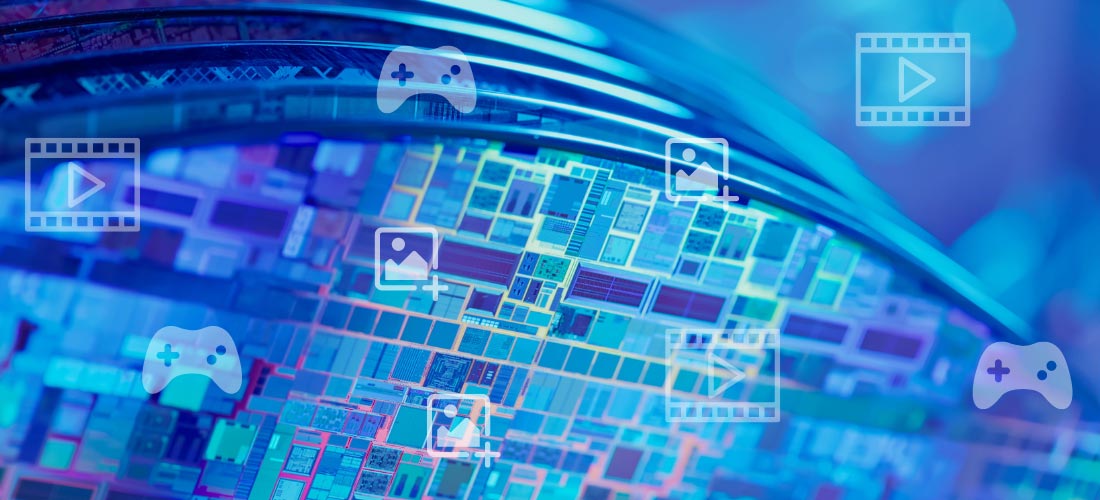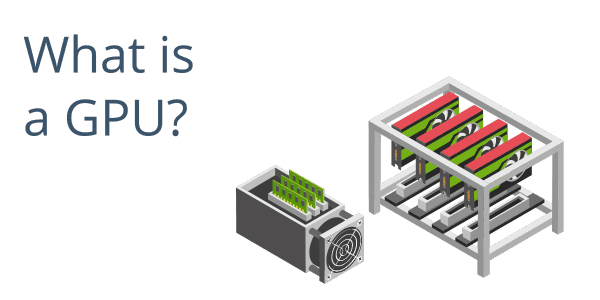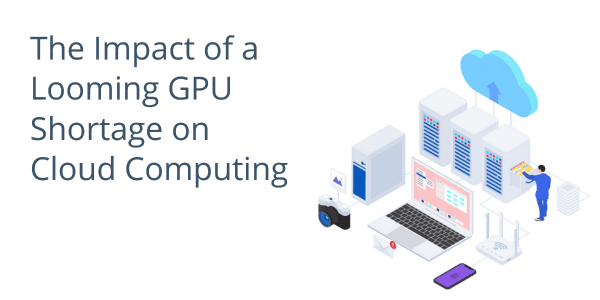
17 Aug Understanding GPUs and Their Impact on Cloud Computing
Graphics Processing Units (GPU) came into existence because the graphic demands for games, photos, and video applications were beyond the resources of main computer components like the stalwart CPU.
However, games and multimedia are just some of the outward representations of what a GPU does – which is tons of complicated calculations simultaneously.
Despite the name, this makes GPUs powerhouses in data analysis, machine learning, and the repetitive tasks behind AI.
Because of this, companies have created purpose-built infrastructure with a GPU at the heart as a code component instead of conventional server, or server-like, entities.
 What is a GPU?
What is a GPU?
Graphics Processing Units (GPUs) are specialized processors designed for handling graphics and parallel processing tasks. In recent years, their capabilities have extended beyond graphics to handle various computationally intensive tasks.
As cloud computing continues to revolutionize the tech industry, Graphics Processing Units (GPUs) have emerged as key components to accelerate performance and cater to the increasing demand for artificial intelligence (AI) services.
When integrated into cloud computing environments, GPUs offer significant benefits for users and businesses seeking high-performance computing resources without expensive hardware investments.
What is Parallel Processing?
GPUs are built with thousands of small processing cores that work in parallel, performing multiple calculations simultaneously. This parallel architecture enables GPUs to excel at complex computations, significantly speeding up tasks that can be parallelized.
 What are Some of the Primary Applications for GPUs?
What are Some of the Primary Applications for GPUs?
In cloud computing, GPUs are integrated into virtual machines, allowing users to access their computational power remotely.
Some key applications include:
- GPUs are essential for training and deploying machine learning models.
- GPUs accelerate data analytics and database queries, efficiently handling parallelizable operations like matrix multiplication and filtering.
- In virtual desktops, GPUs render high-quality graphics, delivering a smooth user experience on remote devices.
- GPUs accelerate video processing tasks, making real-time video streaming and content processing more efficient.
How Do GPUs Offer Simplified Programming?
To harness GPU power, developers use APIs like CUDA (for NVIDIA GPUs) or OpenCL (for various GPU architectures). These APIs simplify programming tasks, enabling applications to leverage GPU processing power without complex hardware-level integration.
GPUs in the News: Microsoft’s GPU Investment and Cloud Growth
In its latest annual report, Microsoft highlighted the pivotal role GPUs play in its rapidly growing cloud business.
While never mentioned specifically before, this year GPUs appeared in three separate mentions in the document.
The company has been ramping up capital expenditures, including GPU purchases, to meet the escalating demand for cloud-based AI services.
GPUs, with their ability for parallel processing, offer immense computational power and are crucial for training machine learning models, rendering graphics, and processing big data.
 The Impact of a Looming GPU Shortage on Cloud Computing
The Impact of a Looming GPU Shortage on Cloud Computing
Microsoft’s acknowledgment of GPUs as essential infrastructure reflects the increasing hardware demands for providing AI services to small businesses. With GPUs integrated into data centers, cloud applications can offload computationally intensive tasks, ensuring faster and more efficient execution.
“Our datacenters depend on the availability of permitted and buildable land, predictable energy, networking supplies, and servers, including graphics processing units (‘GPUs’) and other components,” Microsoft stated in the regulatory filing.
As cloud hosting consumers, understanding the significance of GPUs in cloud services can help businesses make informed decisions about optimizing their computational needs.
The Impact of Microsoft’s Collaboration with OpenAI
Microsoft’s partnership with OpenAI, a company supported by Microsoft and known for developing advanced AI models like ChatGPT, further drives the demand for GPUs.
By leveraging Microsoft’s Azure cloud services, OpenAI relies on substantial computational resources, necessitating a focus on securing additional GPU capacity.
Microsoft’s commitment to AI technology and the success of ChatGPT are contributing to the company’s need for more GPUs than initially anticipated.
As the AI boom continues, Microsoft is actively seeking computing capacity outside its data centers through partnerships with available leases of GPUs to third-party developers.
Service Reliability Remains a Top Priority
While GPUs significantly enhance cloud services, the growing reliance on AI tools and cloud infrastructure poses potential challenges. Microsoft’s data centers host an extensive user base, and any interruption could impact multiple services, making maintaining service reliability a top priority.
In Conclusion
GPUs offer immense processing power in cloud computing environments, enabling faster and more efficient execution of computationally demanding tasks. GPUs optimize machine learning, big data processing, graphics rendering, and video tasks without the need for substantial hardware investments.
As demand for these components will only be increasing as demand for AI escalates, creative resource sharing options are being openly considered to maintain service without interruption to consumers of cloud services.
 Need Help Making Your Network More Robust, Increasing Business Productivity, Or Capping Escalating Technology Costs?
Need Help Making Your Network More Robust, Increasing Business Productivity, Or Capping Escalating Technology Costs?
Our trained team of cloud computing experts can help you by developing the most secure and efficient cloud-based storage and processing solutions for your business.
Let us demonstrate exactly what Cyberlink can do for you – using your own data and workflows.
 What is a GPU?
What is a GPU? What are Some of the Primary Applications for GPUs?
What are Some of the Primary Applications for GPUs? The Impact of a Looming GPU Shortage on Cloud Computing
The Impact of a Looming GPU Shortage on Cloud Computing Need Help Making Your Network More Robust, Increasing Business Productivity, Or Capping Escalating Technology Costs?
Need Help Making Your Network More Robust, Increasing Business Productivity, Or Capping Escalating Technology Costs?